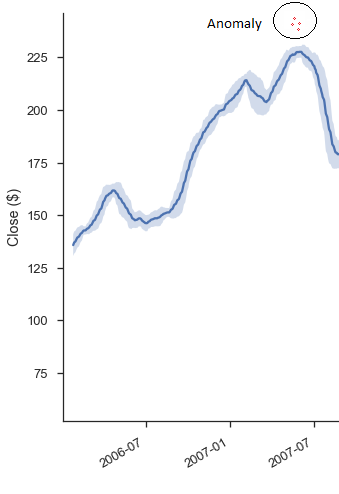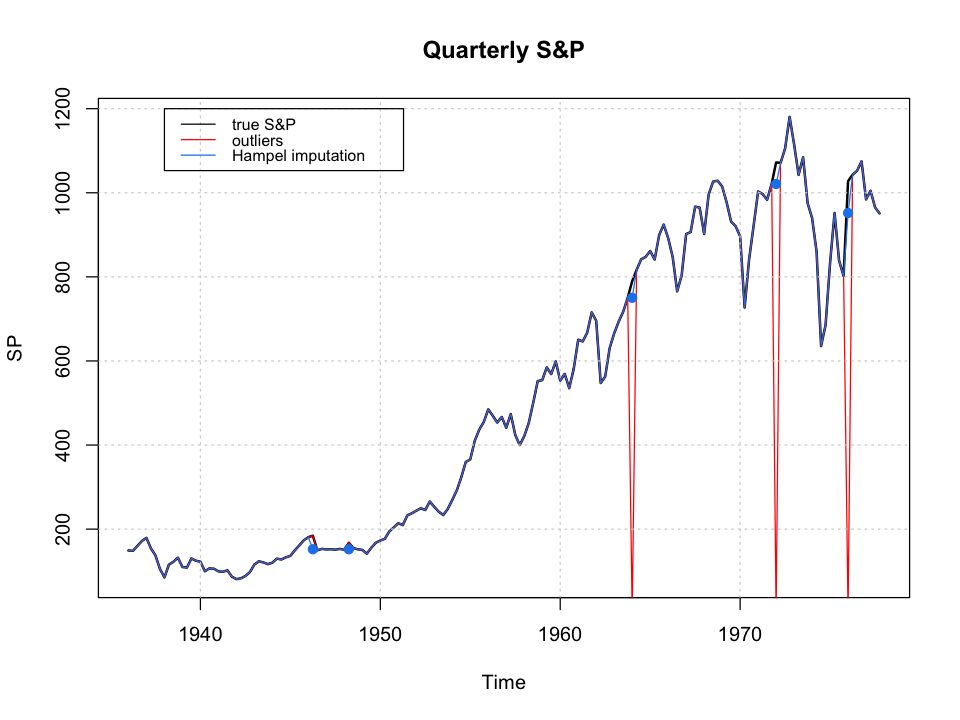Outlier treatment is another important step in data pre-processing and can be performed before missing value imputation one may prefer doing missing value treatment once outliers are treated especially if using mean imputation as outlier can skew the data. These data points which are way too far from zero will be treated as the outliers.
Time Series Anomaly Detection Algorithms By Pavel Tiunov Cube Dev
Correct answer I do.

How to treat outliers in time series. I found one saying to c alculate the IQR interquantile range Q3 minus Q1 then multiply by 15 and adding the amount to Q3 and substracting that from Q1 lower limit. For seasonal time series the seasonal component from the STL fit is removed and the seasonally adjusted series is linearly interpolated to replace the outliers before re-seasonalizing the result. An easy way to do all this for an offline algorithm is to fit a polynomial or spline to the time series then compute the difference between your time series and the fitted polynomialspline.
The resulting time series of residuals can then have some basic statistics computed on it to find outliers for example any data points outside of 15 interquartile-range could be classified as an outlier. If a time series is plotted outliers are usually the unexpected spikes or dips of observations at given points in time. If x up_lim or x.
For non-seasonal time series outliers are replaced by linear interpolation. See Section 53 for a discussion of outliers in a regression context All of the methods we have considered in this book will not work well if there are extreme outliers in the data. I have a time series analysis to model NDVI.
First at the time when the parameters detecting and handling outliers and s tructure changes in a are known. In this method by using Inter Quartile RangeIQR we detect outliers. The study considers the detection of this paper therefore is to consider unified methods for outlier in two cases.
Z-score re-scale and center Normalize the data and look for data points which are too far from zero center. The primary goal of the detection of outlier. Throw out or smooth any values where the observed value changes more than that.
Correct answer I do Who then provides causals to explain the outliers to the system. My data is a time series with multiple variables by districts. IQR Q3 - Q1 printInterquartile range is IQR low_lim Q1 - 15 IQR up_lim Q3 15 IQR printlow_limit is low_lim printup_limit is up_lim outlier for x in jr_boxing_weight_categories.
An easy way to do all this for an offline algorithm is to fit a polynomial or spline to the time series then compute the difference between your time series and the fitted polynomialspline. But I am not sure how to. In most of the cases a threshold of 3 or -3 is used ie if the Z-score value is greater than or less than 3 or -3 respectively that data point will be identified as outliers.
From scipy import stats znpabs statszscore dfhp print z Step 4. They may be errors or they may simply be unusual. Outlierappendx print outlier in the dataset is outlier.
Does the system adjust for outliers in a time series regresion ie ARIMAXTransfer Function. Correct answer Yes Who tries to find the assignable cause why the outliers existed. The R package tsoutliers implements the Chen and Liu procedure for detection of outliers in time series.
Removing outlier from time series analysis using pandas. Data points far from zero will be treated as the outliers. IQR tells us the variation in the data set.
District date Variable1 I looked online to fine a solution to dealing with outliers. A temporal dataset with outliers have several characteristics. Outliers are observations that are very different from the majority of the observations in the time series.
Check shape of data. Decide how auto-correlative your usual event in the time series is. We find the z-score for each of the data point in.
The resulting time series of residuals can then have some basic statistics computed on it to find outliers for example any data points outside of 15 interquartile-range could be classified as an outlier. In other words If ever I see the temperature changing more than 30 degrees in an hour Im. Second when the parameters are unknown.
Outlier as such is an observation that lies on an abnormal distance. Import numpy as np from pandas import Series from matplotlib import pyplot series Seriesfrom_csv WSC-10-50csv header0 pyplotsubplots figsize 20 10 pyplotplot series pyplotshow print series. You may have a look at the following packages available in R.
There is systematic pattern which is deterministic and some variation which is stochastic Only a few data points are outliers. Any value which is beyond the range of -15 x IQR to 15 x IQR treated as outliers. I used the following code.
In most of the cases a threshold of 3 or -3 is used ie if the Z-score value is greater than or less than 3 or -3 respectively that data point will be identified as outliers. For example Im tracking temperature over time and it rarely changes more than 30 degrees F in an hour. Get the Z-score table.
The R package forecast uses loess decomposition of time series to identify and replace outliers.

When Should You Delete Outliers From A Data Set Atlan Humans Of Data Principal Component Analysis Data Data Science

Understanding Outliers In Time Series Analysis Arcgis Pro Documentation

Understanding Outliers In Time Series Analysis Arcgis Pro Documentation

Understanding Outliers In Time Series Analysis Arcgis Pro Documentation

Detecting Outliers In Time Series Ls Ao Tc Using Tsoutliers Package In R How To Represent Outliers In Equation Format Cross Validated

Anomaly Detection In Time Series With Prophet Library By Insaf Ashrapov Towards Data Science

Clean Up Your Time Series Data With A Hampel Filter By Willie Wheeler Wwblog Medium

Clean Up Your Time Series Data With A Hampel Filter By Willie Wheeler Wwblog Medium

0 comments:
Post a Comment